Investigating the Preferences for Hospital Landscape Design: Results of a Pilot Study from Poland
Abstract
1. Introduction
Literature Review—Physical Elements of Hospital Gardens
- −
- opportunities to make choices, seek privacy, and experience a sense of control
- −
- opportunities which encourage people to gather together and experience social support
- −
- opportunities for physical movement and exercise
- −
- engagement with nature
- −
- visibility
- −
- accessibility
- −
- sense of security
- −
- physiological comfort
- −
- familiarity
- −
- quiet
- −
- unambiguously positive design features [42]
2. Materials and Methods
- basic demographic,
- esthetic preferences for landscape design based on photographs of various gardens,
- the relationship between the feelings associated with healthcare setting environments—actual and expected design,
- recommendations on recreational infrastructure and whether it should be open to all visitors.
2.1. The Questionnaire
2.1.1. Basic Demographic
2.1.2. Esthetic Preferences for Landscape Design Based on Photographs of Various Gardens
2.1.3. Relationship Between Feelings Associated with Healthcare Setting Environments—Actual and Expected Design
2.1.4. Recommendations on Recreational Infrastructure and Whether It Should Be Open to All Visitors
3. Research Results
3.1. Basic Demographic
3.2. Esthetic Preferences for Landscape Design Based on Photographs of Various Gardens—Results
3.3. Esthetic Preferences for Landscape Design Based on Photographs of Various Gardens
3.4. Relationship Between the Feelings Associated with Healthcare Setting Environments—Actual and Expected Design—Results
3.5. Recommendations on Recreational Infrastructure and Whether It Should Be Open to All Visitors—Results
4. Discussion
4.1. Contact with Nature
4.2. Calm, Ordered Design
4.3. Design Features
4.4. Limitations
5. Conclusions
5.1. Awareness of Contact with Nature Benefits
5.2. Specific Landscape Features Preferred
Author Contributions
Funding
Institutional Review Board Statement
Informed Consent Statement
Data Availability Statement
Conflicts of Interest
References
- Beil, K.; Hanes, D. The influence of urban natural and built environments on physiological and psychological measures of stress—A pilot study. Int. J. Environ. Res. Public Health 2013, 10, 1250–1267. [Google Scholar] [CrossRef]
- Jiang, B.; Chang, C.-Y.; Sullivan, W.C. A dose of nature: Tree cover, stress reduction, and gender differences. Landsc. Urban Plan. 2014, 132, 26–36. [Google Scholar] [CrossRef]
- Frumkin, H. Beyond toxicity: Human health and the natural environment. Am. J. Prev. Med. 2001, 20, 234–240. [Google Scholar] [CrossRef]
- Kaplan, R.; Kaplan, S. The Experience of Nature: A Psychological Perspective; Cambridge University Press: Cambridge, UK, 1989. [Google Scholar]
- Sullivan, W.C.; Kaplan, R. Nature! Small steps that can make a big difference. HERD Health Environ. Res. Des. J. 2016, 9, 6–10. [Google Scholar] [CrossRef]
- Bell, S.L.; Foley, R.; Houghton, F.; Maddrell, A.; Williams, A.M. From therapeutic landscapes to healthy spaces, places and practices: A scoping review. Soc. Sci. Med. 2018, 196, 123–130. [Google Scholar] [CrossRef]
- Ulrich, R.S.; Biophilia, B. Natural Landscapes. In The Biophilia Hypothesis; Kellert, S.E., Wilson, E., Eds.; Island Press: Washington, DC, USA, 1993; pp. 73–137. [Google Scholar]
- Van Herzele, A.; De Vries, S.J.P. Linking green space to health: A comparative study of two urban neighbourhoods in Ghent, Belgium. Popul. Environ. 2012, 34, 171–193. [Google Scholar] [CrossRef]
- Carrus, G.; Scopelliti, M.; Lafortezza, R.; Colangelo, G.; Ferrini, F.; Salbitano, F.; Agrimi, M.; Portoghesi, L.; Semenzato, P.; Sanesi, G. Go greener, feel better? The positive effects of biodiversity on the well-being of individuals visiting urban and peri-urban green areas. Landsc. Urban Plan. 2015, 134, 221–228. [Google Scholar] [CrossRef]
- Chang, C.-Y.; Hammitt, W.E.; Chen, P.-K.; Machnik, L.; Su, W.-C. Psychophysiological responses and restorative values of natural environments in Taiwan. Landsc. Urban Plan. 2008, 85, 79–84. [Google Scholar] [CrossRef]
- Fisher, J.C.; Irvine, K.N.; Bicknell, J.E.; Hayes, W.M.; Fernandes, D.; Mistry, J.; Davies, Z.G. Perceived biodiversity, sound, naturalness and safety enhance the restorative quality and wellbeing benefits of green and blue space in a neotropical city. Sci. Total Environ. 2021, 755, 143095. [Google Scholar] [CrossRef] [PubMed]
- Maas, J.; Verheij, R.A. Morbidity is related to a Green living environment. J. Epidemiol. Community Health 2009, 63, 967–973. [Google Scholar] [CrossRef] [PubMed]
- Lovasi, G.S.; Quinn, J.W.; Neckerman, K.M.; Perzanowski, M.S.; Rundle, A. Children living in areas with more street trees have lower prevalence of asthma. J. Epidemiol. Community Health 2008, 62, 647. [Google Scholar] [CrossRef]
- Trojanowska, M. Parki i Ogrody Terapeutyczne; Wydawnictwo Naukowe PWN: Warszawa, Poland, 2017. [Google Scholar]
- Trojanowska, M. Biblical Gardens and the Resilience of Cultural Landscapes—A Case Study of Gdańsk, Poland. Land 2023, 12, 137. [Google Scholar] [CrossRef]
- Trojanowska, M. Assessment of sustainability and health promotion of three public parks in Poland’s Pomerania Region. Bull. Geogr. Socio-Econ. Ser. 2024, 117–136. [Google Scholar] [CrossRef]
- Cooper Marcus, C.; Barnes, M. Gardens in Health Care Facilities: Uses, Therapeutic Benefits, and Design Considerations; The Center of Health Design, Inc.: Concord, CA, USA, 1995. [Google Scholar]
- Cooper Marcus, C.; Barnes, M. Healing Gardens. Therapeutic Benefits and Design Recommendations; Wiley: New York, NY, USA, 1999. [Google Scholar]
- Cooper-Marcus, C.; Sachs, N. Therapeutic Landscapes. An Evidence-Based Approach to Designing Healing Gardens and Restorative Outdoor Spaces; John Wiley & Sons, Inc.: Hoboken, NJ, USA, 2014; pp. 14–35. [Google Scholar]
- Gerlach-Springss, N.; Kaufman, R.E.; Warner, S.B. Restorative Gardens; Yale University: New Haven, CT, USA, 1998. [Google Scholar]
- Eckerling, M. Guidelines for designing healing gardens. J. Ther. Horticult. 1996, 8, 21–25. [Google Scholar]
- Winterbotton, D.; Wagenfeld, A. Therapeutic Gardens. Design for Healing Spaces; Timber Press: Portland, OR, USA, 2015. [Google Scholar]
- Souter-Brown, G. Landscape and Urban Design for Health and Well-Being: Using Healing, Sensory and Therapeutic Gardens; Routledge: London, UK, 2015. [Google Scholar]
- Zhu, L.; Sarah, J.S. History and Evolution of the Healing Gardens: Investigating the Building-Nature Relationship in the Healthcare Setting. SSM Qual. Res. Health 2024, 6, 100450. [Google Scholar] [CrossRef]
- Ode, A.; Fry, G.; Tveit, M.S.; Messager, P.; Miller, D. Indicators of perceived naturalness as drivers of landscape preference. J. Environ. Manag. 2009, 90, 375–383. [Google Scholar] [CrossRef]
- Knez, I.; Sang, Å.; Gunnarsson, B.; Hedblom, M. Wellbeing in Urban Greenery: The Role of Naturalness and Place Identity. Front. Psychol. 2018, 9, 491. [Google Scholar] [CrossRef] [PubMed]
- Ibrahim, F.; Harun, W.M.W.; Samad, M.H.A.; Kamaruddin, W. The physical attributes of Healing Garden for a century old healthcare premises. Int. Trans. J. Eng. Manag. Appl. Sci. Technol. 2015, 6, 47–59. [Google Scholar]
- Relf, P.D. The Therapeutic Values of Plants. Pediatr. Rehabilation 2005, 8, 235–237. [Google Scholar] [CrossRef]
- Stigsdotter, U.A.; Grahn, P. What Makes a Garden a Healing Garden? J. Ther. Hortic. 2002, 13, 60–69. [Google Scholar]
- George, D.R.; Ethridge, A.E. Hospital-Based Community Gardens as a Strategic Partner in Addressing Community Health Needs. Am. J. Public Health 2023, 113, 939–942. [Google Scholar] [CrossRef]
- Wyatt, C. The History of the Secret Garden, Glenfield Hospital. Fam. Community Hist. 2021, 24, 270–288. [Google Scholar] [CrossRef]
- Carman, J.; Hines, K.; Koepke, M.; Samuel, O. Development of the Neuro Critical Care Unit Garden at Emory University Hospital. J. Ther. Hortic. 2011, 21, 30–39. [Google Scholar]
- Davis, B.E. Rooftop Hospital Gardens for Physical Therapy: A Post-Occupancy Evaluation. HERD Health Environ. Res. Des. J. 2011, 4, 14–43. [Google Scholar] [CrossRef] [PubMed]
- Ulrich, R.S. View through a window may influence recovery from surgery. Science 1984, 224, 420–421. [Google Scholar] [CrossRef] [PubMed]
- Pasha, S. Barriers to garden visitation in children’s hospitals. Health Environ. Res. Des. J. 2013, 6, 76–96. [Google Scholar] [CrossRef]
- Völker, S.; Kistemann, T. The impact of blue space on human health and well-being—Salutogenic health effects of inland surface waters: A review. Int. J. Hyg. Environ. Health 2011, 214, 449–460. [Google Scholar] [CrossRef]
- Falk, J. Landscape Preferences. In Encyclopedia of Evolutionary Psychological Science; Springer: Cham, Switzerland, 2020; pp. 1–8. [Google Scholar] [CrossRef]
- Steptoe, A.; Wardle, J.; Marmot, M. Positive affect and health-related neuroendocrine, cardiovascular, and inflammatory processes. Proc. Natl. Acad. Sci. USA 2005, 102, 6508–6512. [Google Scholar] [CrossRef]
- Fredrickson, B.L.; Joinser, T. Positive emotions trigger upward spirals toward emotional well-being. Psychol. Sci. 2002, 13, 172–175. [Google Scholar] [CrossRef]
- Cooper-Marcus, C. Gardens and Health. Available online: https://www.brikbase.org/sites/default/files/Clare-Cooper-Marcus-WCDH2000.pdf (accessed on 3 August 2024).
- Cooper Marcus, C.; Francis, C. People Places: Design Guidelines for Urban Open Space; John Wiley & Sons: New York, NY, USA, 1998. [Google Scholar]
- Cooper Marcus, C. Healing gardens in hospitals. In The Architecture of Hospitals; Wagenaar, C., Ed.; NAi Publishers: Rotterdam, The Netherlands, 2005; pp. 314–329. [Google Scholar]
- Keswick-Jencks, M. A View from the Front Line. 1995. Available online: https://www.maggies.org/media/filer_public/59/89/5989b1c0-5ba4-4473-8c29-07a2f591f148/a-view-from-the-front-line.pdf (accessed on 5 July 2024).
- Whitehouse, S.; Varni, J.W.; Seid, M.; Cooper-Marcus, C.; Ensberg, M.J.; Jacobs, J.R.; Mehlenbeck, R.S. Evaluating a children’s hospital garden environment: Utilization and consumer satisfaction. J. Environ. Psychol. 2001, 21, 301–314. [Google Scholar] [CrossRef]
- Deng, L.; Li, X.; Luo, H.; Fu, E.K.; Ma, J.; Sun, L.X.; Huang, Z.; Cai, S.; Jia, Y. Empirical study of landscape types, landscape elements and landscape components of the urban park promoting physiological and psychological restoration. Urban For. Urban Green. 2020, 48, 126488. [Google Scholar] [CrossRef]
- Tugade, M.M.; Fredrickson, B.L.; Feldman Barrett, L. Psychological Resilience and Positive Emotional Granularity: Examining the Benefits of Positive Emotions on Coping and Health. J. Personal. 2004, 72, 1161–1190. [Google Scholar] [CrossRef] [PubMed]
- Bengtsson, A.; Grahn, P. Outdoor environments in healthcare settings: A quality evaluation tool for use in designing healthcare gardens. Urban For. Urban Green. 2014, 13, 878–891. [Google Scholar] [CrossRef]
- Rodiek, S.D. How the built environment affects outdoor usage at assisted living facilities for the frail elderly. In Proceedings of the Postgraduate Research Conference, Cardiff, UK, 10 May 2003; pp. 65–78, ISBN 1-899895-34-5. [Google Scholar]
- Rodiek, S.; Fried, J. Access to the outdoors: Using photographic comparison to assess preferences of assisted living residents. Landsc. Urban Plan. 2005, 73, 184–199. [Google Scholar] [CrossRef]
- Posit Team. RStudio: Integrated Development Environment for R; Posit Software, PBC: Boston, MA, USA, 2025; Available online: http://www.posit.co/ (accessed on 15 April 2025).
- R Core Team. R: A Language and Environment for Statistical Computing; R Foundation for Statistical Computing: Vienna, Austria, 2024; Available online: https://www.R-project.org/ (accessed on 15 April 2025).
- Ozgüner, H.; Kendle, A.D. Public attitudes towards naturalistic versus designed landscapes in the city of Sheffield (UK). Landsc. Urban Plan. 2006, 74, 139–157. [Google Scholar] [CrossRef]
- ACL Manual. Available online: https://www.practest.com.pl/sklep/test/ACL (accessed on 7 July 2024).
- Martowska, K.; Matczak, A.; Wrocławska-Warchala, E. Możliwości Interpretacji Czynnikowej Wyników Badania Listą Przymiotnikową ACL, Przegląd Psychologiczny, t. 58, Nr 2/2015. Available online: https://www.researchgate.net/publication/283503395_Mozliwosci_interpretacji_czynnikowej_wynikow_badania_Lista_Przymiotnikowa_ACL_The_possibilities_of_factor-based_interpretation_of_the_results_of_research_using_the_Adjective_Check_List (accessed on 7 July 2024).
- Climate of Poland, Encyclopedia Britannica. Available online: https://www.britannica.com/place/Poland/Climate (accessed on 3 August 2024).
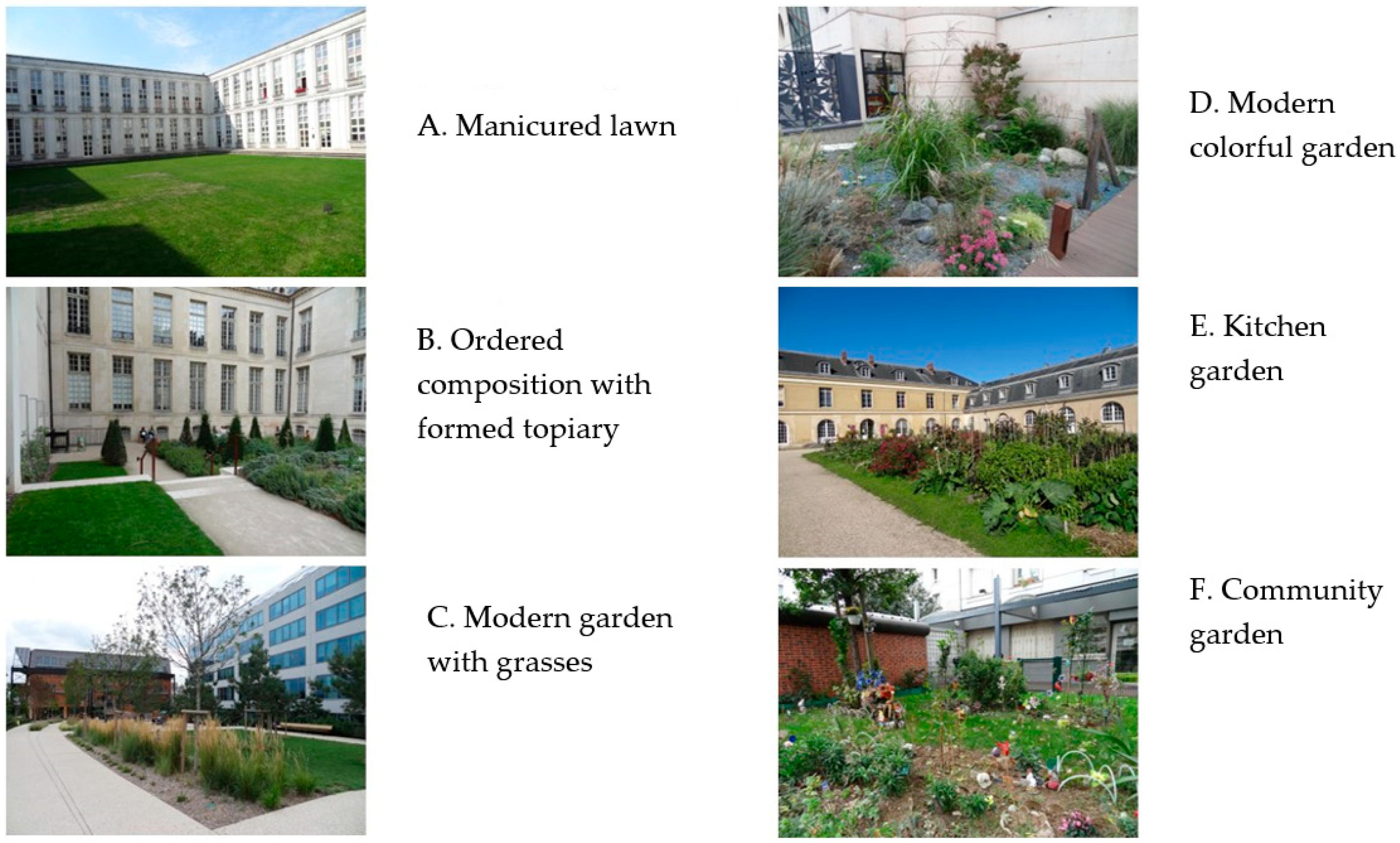


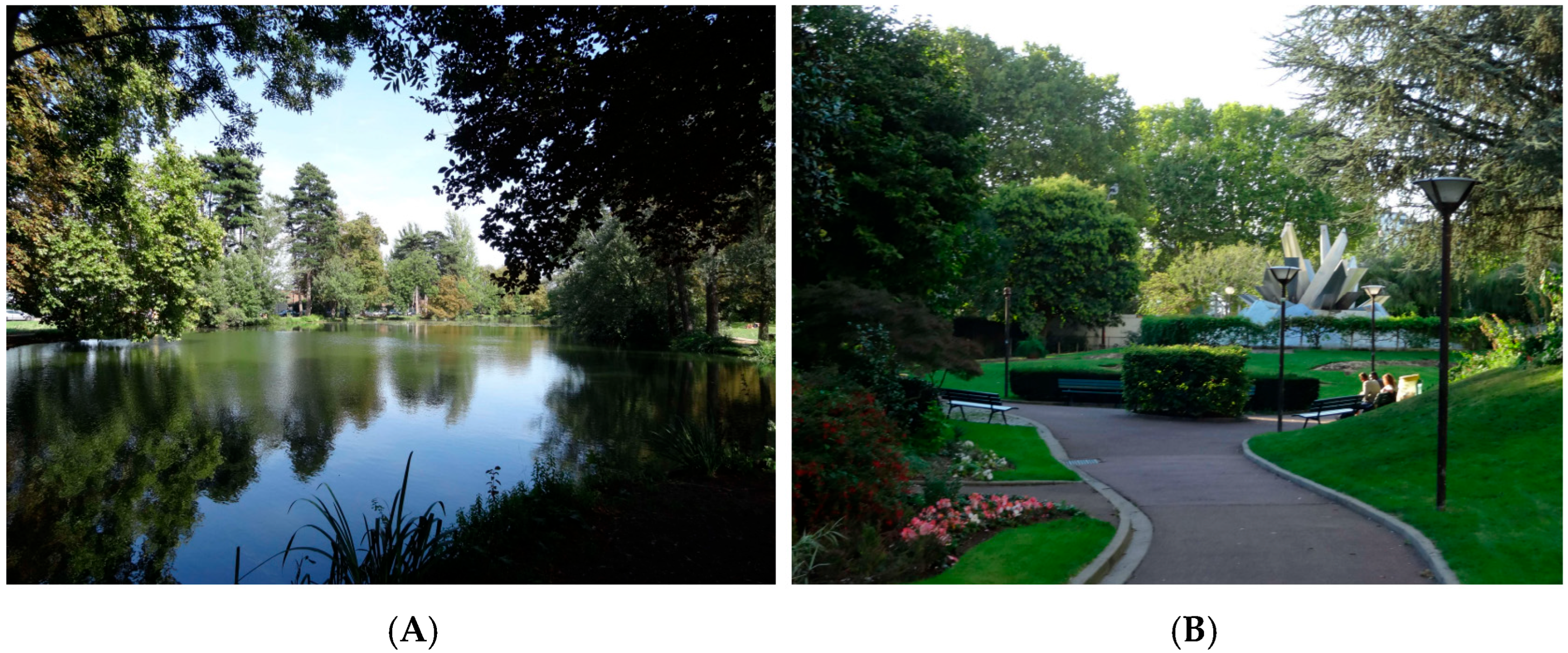
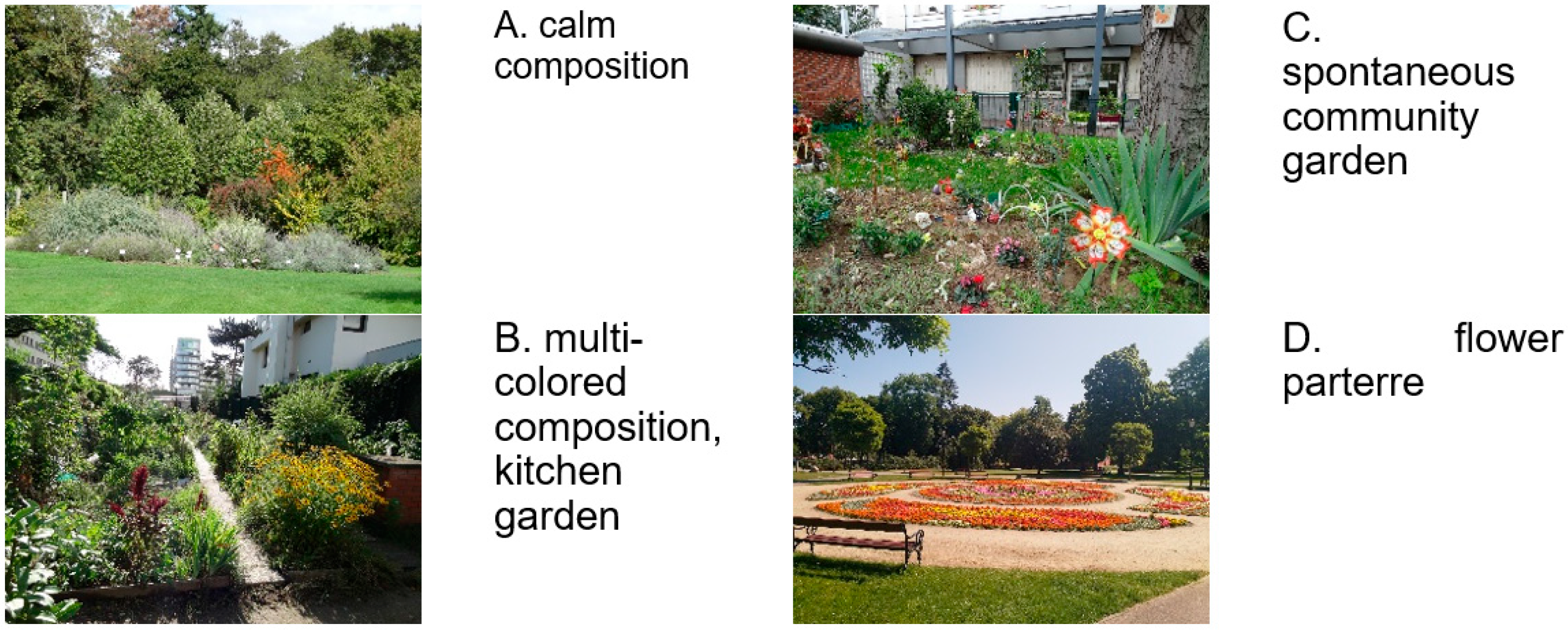
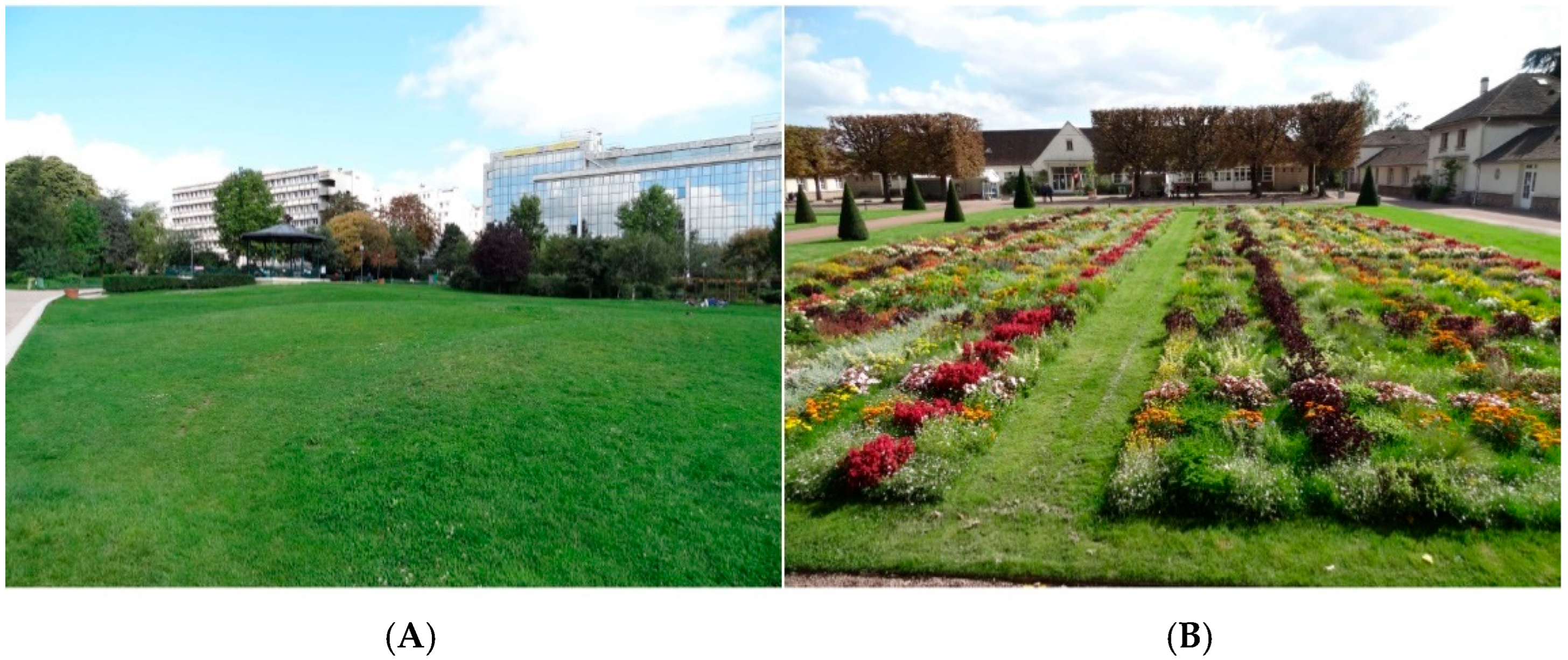
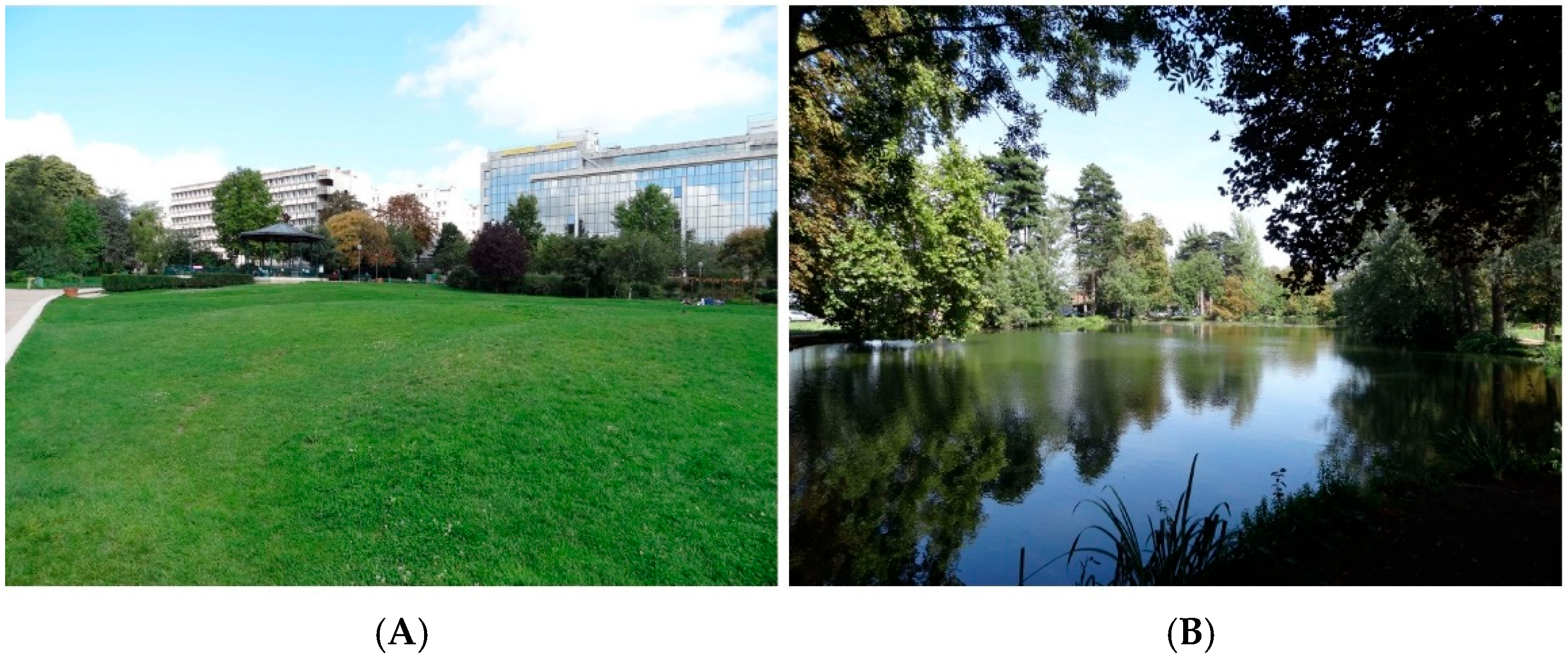
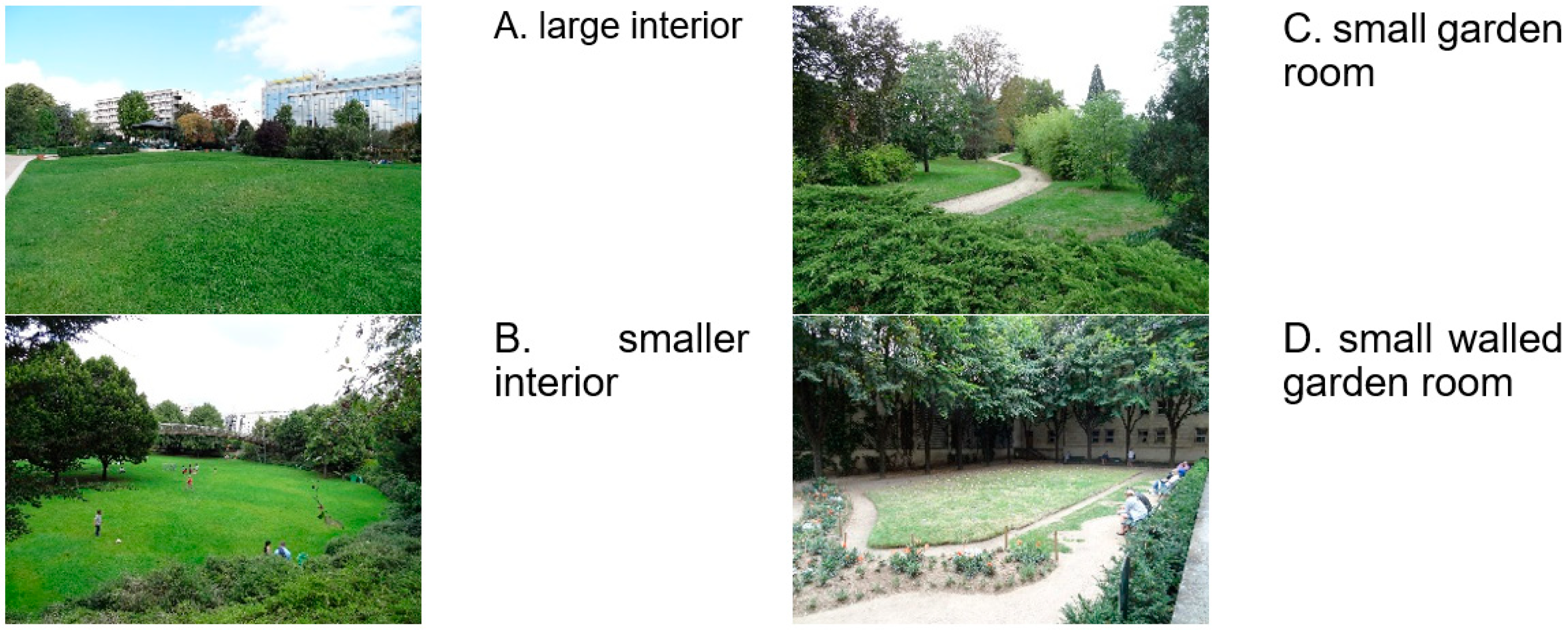

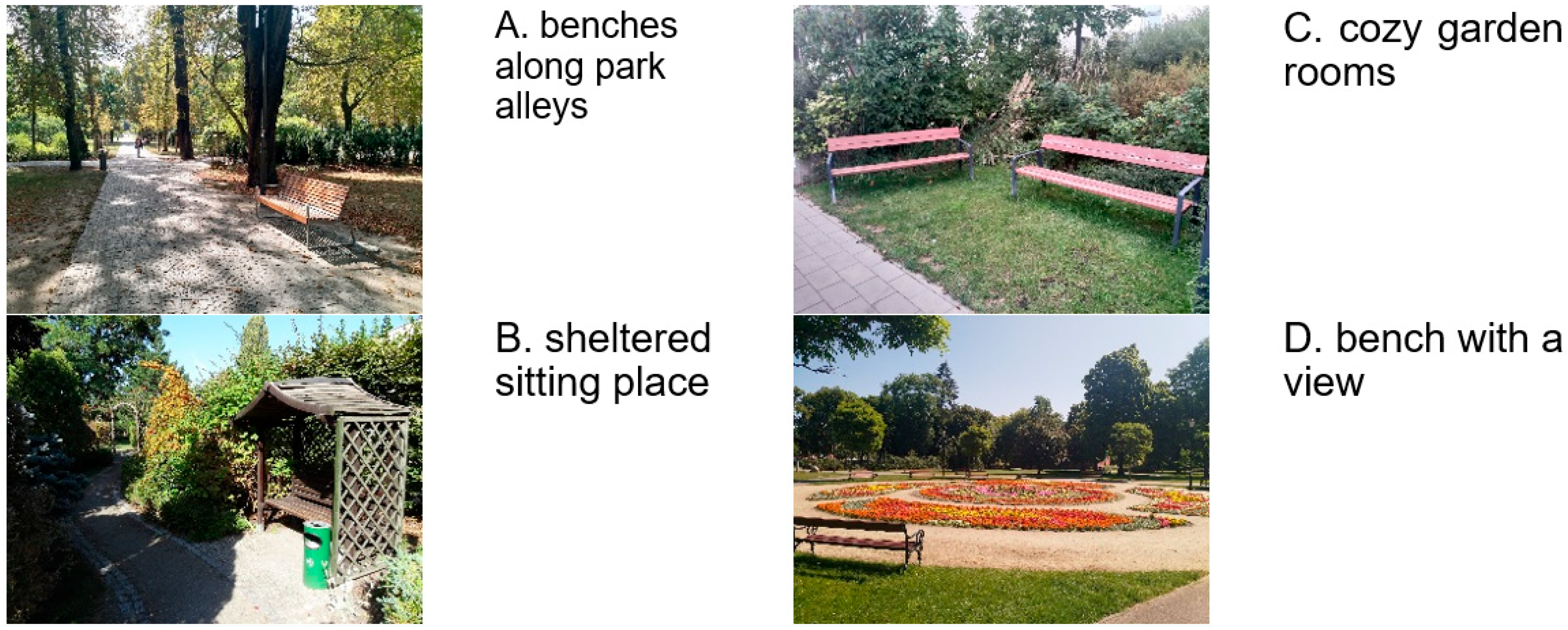
| Attributes/Features |
|---|
| providing relief |
| causing distress |
| eye-catching |
| not paying attention |
| neutral |
| well-ordered |
| chaotic |
| monotonous |
| varied |
| uniform |
| contrasting |
| depressing |
| hope-giving |
| sad |
| joyful |
| multi-colored |
| one-colored |
| shaded |
| sunny |
| pessimism-generating |
| optimism-generating |
| not promoting regeneration |
| promoting regeneration |
| causing fear |
| giving a sense of security |
| variety of species |
| wildness of nature unchanged by humans |
| space |
| safe, separated garden zone |
| meeting place |
| place with fascinating history |
| peaceful |
| fascinating, paying attention |
| allowing one to break away from problems |
| allowing one to feel comfortable |
| meeting expectations |
| sex | n | % |
| woman | 90 | 81.8 |
| man | 20 | 18.2 |
| age | n | % |
| 18–25 | 47 | 42.7 |
| 26–40 | 25 | 22.8 |
| 41–60 | 34 | 30.9 |
| 60< | 4 | 3.6 |
| Answers: Yes | Is Contact with Nature Important to You? | Does the Environment of a Healthcare Facility Impact the Health and Well-Being of Patients? | Does the Environment of a Healthcare Facility Affect the Quality of Staff Work? | Does the Environment of a Healthcare Facility Impact the Health and Well-Being of Patient Family Members? | ||||
|---|---|---|---|---|---|---|---|---|
| 89.1% | 96.3% | 85.5% | 89.1% | |||||
| sex | % | Sig. | % | Sig. | % | Sig. | % | Sig. |
| woman | 90.0 | 0.454 | 97.8 | 0.155 | 85.6 | 0.417 | 91.1 | 0.140 |
| man | 85.0 | 90.0 | 85.0 | 80.0 | ||||
| age | % | Sig. | % | Sig. | % | Sig. | % | Sig. |
| 18–25 | 80.9 | 0.196 | 93.6 | 0.246 | 89.4 | 0.539 | 89.4 | 0.681 |
| 26–40 | 96.0 | 96.0 | 84.0 | 88.0 | ||||
| 41–60 | 94.1 | 100.0 | 824 | 91.2 | ||||
| 60< | 100.0 | 100.0 | 75.0 | 75.0 | ||||
| Everyday | Once a Week | Once a Month or Less | ||
|---|---|---|---|---|
| 35.8% | 43.1% | 21.1% | ||
| sex | % | Sig. | ||
| woman | 38.2 | 41.6 | 20.2 | 0.536 |
| man | 25.0 | 50.0 | 25.0 | |
| age | % | Sig. | ||
| 18–25 | 26.1 | 54.3 | 19.6 | 0.097 |
| 26–40 | 44.0 | 40.0 | 16.0 | |
| 41–60 | 35.3 | 35.3 | 29.4 | |
| 60< | 100.0 | - | - | |
| How important is the impact of the quality of the environment of a healthcare facility on the health and well-being of the people staying there? | ||
|---|---|---|
| m ± SD | Sig. | |
| 8.65 ± 1.61 | - | |
| sex | m ± SD | Sig. |
| woman | 8.8 ± 1.45 | U = 1023.5, p = 0.313 |
| man | 8.2 ± 2.19 | |
| age | m | Sig. |
| 18–25 | 8.30 ± 1.77 | H = 6.52, p = 0.089 rS = 0.22 |
| 26–40 | 8.64 ± 1.55 | |
| 41–60 | 9.09 ± 1.36 | |
| 60< | 9.25 ± 1.5 | |
| m ± SD | |
|---|---|
| How much importance do you attach to the external environment of the place you are currently in, e.g., the view from the window? | 4.26 ± 0.94 |
| Does the sight of greenery outside your window or in the immediate vicinity of a healthcare facility affect your well-being? To what extent? | 4.52 ± 0.76 |
| Does the view of other people’s activities outside the window/in the immediate vicinity of a healthcare facility affect your well-being? To what extent? | 4.02 ± 0.93 |
| Attributes/Features | Per Cent Reporting n = 100 | |
|---|---|---|
| The feelings associated with healthcare setting environments, as they were, according to respondents, (currently) 100 responses | providing relief | 15% |
| causing distress | 20% | |
| eye-catching | 6% | |
| not paying attention | 36% | |
| neutral | 40% | |
| well-ordered | 22% | |
| chaotic | 15% | |
| monotonous | 41% | |
| varied | 5% | |
| uniform | 19% | |
| contrasting | 4% | |
| depressing | 26% | |
| hope-giving | 10% | |
| sad | 34% | |
| joyful | 8% | |
| multi-colored | 8% | |
| one-colored | 17% | |
| shaded | 17% | |
| sunny | 10% | |
| pessimism-generating | 20% | |
| optimism- generating | 11% | |
| not promoting regeneration | 27% | |
| promoting regeneration | 8% | |
| causing fear | 9% | |
| giving a sense of security | 11% | |
| variety of species | 4% | |
| wildness of nature unchanged by humans | 8% | |
| space | 7% | |
| safe, separated garden zone | 5% | |
| meeting place | 5% | |
| place with fascinating history | 3% | |
| peaceful | 11% | |
| fascinating, paying attention | 3% | |
| allowing one to break away from problems | 6% | |
| allowing one to feel comfortable | 11% | |
| meeting expectations | 7% |
| Attributes/Features | Per Cent Reporting n = 103 | |
|---|---|---|
| The feelings associated with healthcare setting environments, as they should be, according to respondents, (expected) 103 responses | providing relief | 80% |
| causing distress | 2% | |
| eye-catching | 27% | |
| not paying attention | 4% | |
| neutral | 9% | |
| well-ordered | 52% | |
| chaotic | 2% | |
| monotonous | 2% | |
| varied | 24% | |
| uniform | 4% | |
| contrasting | 8% | |
| depressing | 2% | |
| hope-giving | 59% | |
| sad | 1% | |
| joyful | 62% | |
| multi-colored | 46% | |
| one-colored | 4% | |
| shaded | 24% | |
| sunny | 43% | |
| pessimism-generating | 1% | |
| optimism- generating | 55% | |
| not promoting regeneration | 1% | |
| promoting regeneration | 64% | |
| causing fear | 0% | |
| giving a sense of security | 49% | |
| variety of species | 33% | |
| wildness of nature unchanged by humans | 23% | |
| space | 23% | |
| safe, separated garden zone | 44% | |
| meeting place | 42% | |
| place with fascinating history | 9% | |
| peaceful | 50% | |
| fascinating, paying attention | 18% | |
| allowing one to break away from problems | 57% | |
| allowing one to feel comfortable | 60% | |
| meeting expectations | 18% |
Disclaimer/Publisher’s Note: The statements, opinions and data contained in all publications are solely those of the individual author(s) and contributor(s) and not of MDPI and/or the editor(s). MDPI and/or the editor(s) disclaim responsibility for any injury to people or property resulting from any ideas, methods, instructions or products referred to in the content. |
© 2025 by the authors. Licensee MDPI, Basel, Switzerland. This article is an open access article distributed under the terms and conditions of the Creative Commons Attribution (CC BY) license (https://creativecommons.org/licenses/by/4.0/).
Share and Cite
Trojanowska, M.; Matuszewska, J.; Brosz, M. Investigating the Preferences for Hospital Landscape Design: Results of a Pilot Study from Poland. Architecture 2025, 5, 91. https://doi.org/10.3390/architecture5040091
Trojanowska M, Matuszewska J, Brosz M. Investigating the Preferences for Hospital Landscape Design: Results of a Pilot Study from Poland. Architecture. 2025; 5(4):91. https://doi.org/10.3390/architecture5040091
Chicago/Turabian StyleTrojanowska, Monika, Joanna Matuszewska, and Maciej Brosz. 2025. "Investigating the Preferences for Hospital Landscape Design: Results of a Pilot Study from Poland" Architecture 5, no. 4: 91. https://doi.org/10.3390/architecture5040091
APA StyleTrojanowska, M., Matuszewska, J., & Brosz, M. (2025). Investigating the Preferences for Hospital Landscape Design: Results of a Pilot Study from Poland. Architecture, 5(4), 91. https://doi.org/10.3390/architecture5040091





